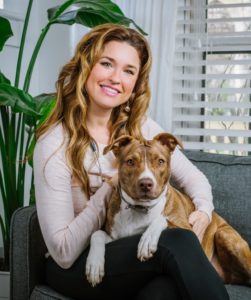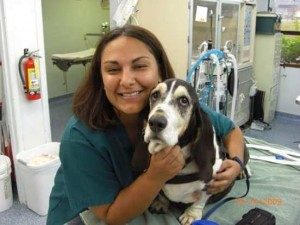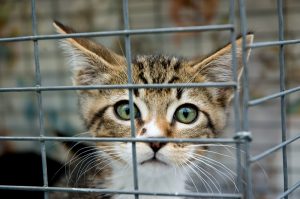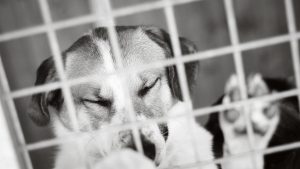We all know that there are people who don’t enjoy the holidays. But did you know that veterinary staff members often dread the holiday season? Why? Well, there’s an odd phenomenon that starts anywhere between Halloween and Thanksgiving and sometimes drags on through March or April – the euthanasia explosion.
There are lots of reasons why there is an increase in pet euthanasia during the holiday season. It’s colder (except here in Florida for some reason), so pets with arthritis or who are very thin are often worse when the temperature drops. There is the stress of changes to the home – decorations, work schedules, visitors.
Pets can be exposed to toxins and foreign bodies that aren’t usually in their environment. Their owners are often very stressed, even if they love the holidays. Stress can cause a flare up of old disease or bring on new diseases in both pets and people. Finances are also pretty tight for many during this festive, gift-laden season. Pet owners sometimes try to wait on veterinary care until after all the chaos (and expense) is over.
Whatever the reason, veterinary teams are performing euthanasia at a much higher rate than usual. Patients we have loved and sometimes known their entire lives are passing. While we band together to provide a peaceful end for our beloved patients and their families, inside we are feeling the weight of grief. For while nothing compares to the loss of your own pet, helping multiple families through this process takes a toll. Compassion fatigue (secondary trauma from helping sick and injured patients and their families) can bring veterinary professionals down, especially when they are trying to navigate their own holiday stresses.
I have some advice for both pet parents and veterinary teams during this time.
Be kind – both halves of a pet’s team of caretakers are under pressure. We all need to remember patience and empathy. Everyone has the same goal: to help the pet. Today I was touched when I thanked a client for her patience because I ran late after performing a euthanasia. She told me she was grateful her pet wasn’t in that position and was happy to sit tight while I helped a grieving family. I didn’t have to apologize for being late, and she didn’t have to give me a gracious response. But because both things happened, we were able to find common ground and help her cat with no conflict standing in our way.
Consider in-home euthanasia – veterinary teams and clients should check and see if anyone offers in-home services in their area. I urge all pet owners to consider having their pets pass at home. It is much less stressful for most pets and clients to not travel to a busy veterinary hospital. So many clients have no idea that house call euthanasia services exist. At the time of a pet’s passing, having options is important. I get referrals from veterinarians all the time, and their clients are grateful that they had the option, even if they don’t take it. To find a list of providers in your area, visit inhomepeteuthanasia.com
Plan ahead – a planned euthanasia is the exception to the rule. Most clients call me the day they need me. We should be staying in close touch with each other when your pet is very ill. We should be talking about the possibility of euthanasia any time there is a serious or chronic illness. The more communication we have, the better off everyone will be. Clients get the support they need and we have a better chance of preventing suffering. If you know a client has a pet that is stressed in the office, consider prescribing some gabapentin, trazodone or other good anti-anxiety drug (NOT ACEPROMAZINE) to use before euthanasia. That way, whether the client comes to you or elects home euthanasia, they can do something to help their pet be less fearful. Leave a little room in the schedule for the inevitable last-minute euthanasia appointment so the team can provide a good passing.
Treat for pain – recognizing pain in pets can be difficult. If your veterinarian says your pet is in pain, please believe them and give their pain medication as directed. Here is some information on pain for pet owners: //ivapm.org/for-the-public/animals-and-pain-articles/ Veterinary teams – please use a multimodal approach to pain control. And please, please, please put down the tramadol. It has been shown to be a poor pain medication for dogs. It does make them sleepy, which can look like pain control. The IVAPM can help you find a better pain control plan. I talk to at least 3 owners a week whose pets are painful and have no pain medications or tramadol is their only medication. We can do better.
“Watch and see” is a gamble. Trying to limp along a pet’s illness until January can have dire consequences. We may be unable to treat or it may be far more expensive to treat once the disease process has progressed. If your pet is having problems, at least contact your veterinarian for advice rather than hope things don’t become critical. Remember that it is against the law for veterinarians to prescribe drugs for a pet they’ve never seen or haven’t seen in a long time. Be sure to keep your pet up-to-date on exams. Vet teams – take the time to figure out how to keep pets as comfortable as possible if their owners can’t or won’t bring them in.
Remember that a pet’s “team” consists of owners and vet professionals working together. We aren’t at war with each other. When it comes to end-of-life care, all of us need to be extra sensitive and try to keep our strong feelings from making us say or do something we’ll regret.
Don’t forget to practice good self-care. None of us can take good care of others if we are not taking good care of ourselves. If you are having trouble, please seek help. www.APLB.org can help with pet loss support before and after a loss. Vet teams, visit this site. Best wishes and many thanks to everyone caring for pets this holiday season.
The views and opinions expressed in this article are those of the author and do not necessarily reflect the position of the DrAndyRoark.com editorial team.

 ABOUT THE AUTHOR
ABOUT THE AUTHOR 



 ABOUT THE AUTHOR
ABOUT THE AUTHOR
